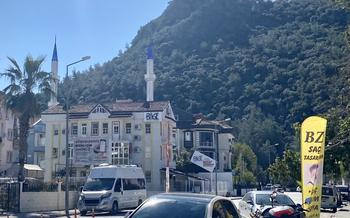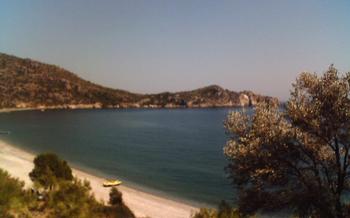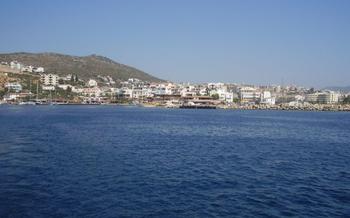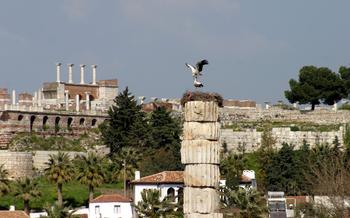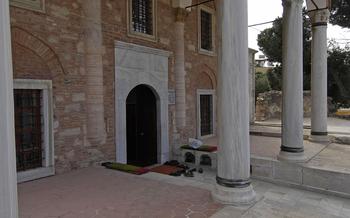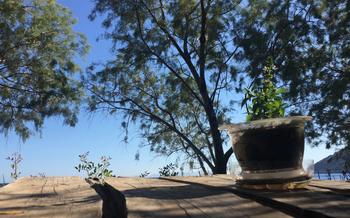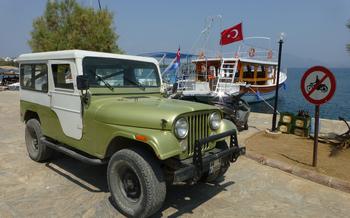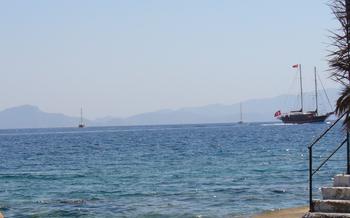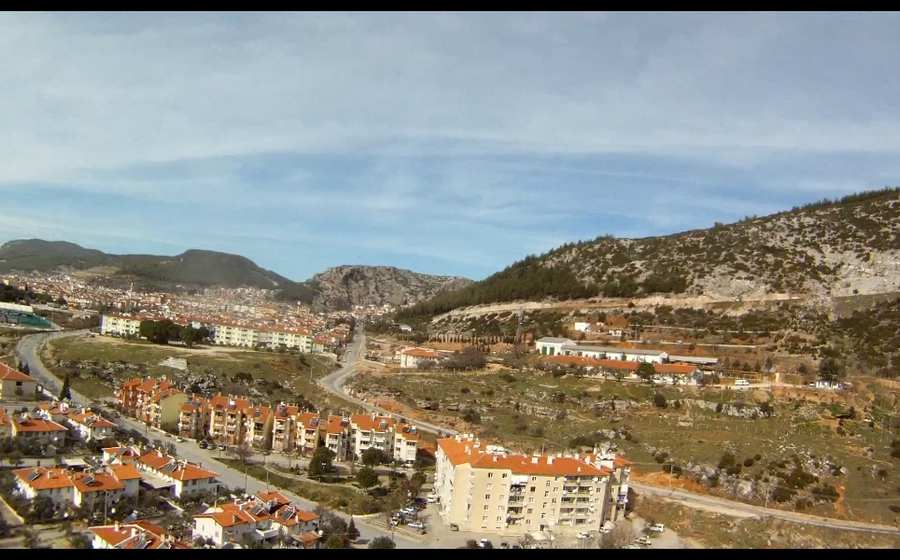
Datça Windmills
- Historical Background
- Cultural Significance
- Location
- Structure
- Functionality
- Restoration
- Tourism Potential
- Visiting the Windmills
- Nearby Attractions
- Things to Do
- Local Cuisine
- Accommodation
- Transportation
- Safety and Security
- Insider Tip: Sunset Views
Historical Background
The Datça windmills stand as proud remnants of a bygone era, silently narrating the tale of a time when the power of nature was harnessed to meet the needs of a thriving community. Constructed in the late 18th century, these architectural wonders played a pivotal role in driving the region's economy, grinding wheat and other grains to produce the flour that sustained its people. Their iconic presence, with their conical roofs and sturdy stone towers, not only shaped the region's skyline but also became deeply embedded in the cultural identity of Datça. These windmills, with their rich historical significance, serve as a testament to the ingenuity and resourcefulness of the local population, who turned the wind's energy into a vital source of sustenance.
Cultural Significance
The Datça windmills stand as proud symbols of the town's identity, deeply embedded in the historical and cultural tapestry of the region. These majestic structures have borne witness to the ebb and flow of time, embodying the resilience and sustainability that have characterized Datça's people throughout the centuries.
As symbols of Datça's rich heritage, the windmills have become an integral part of the town's cultural identity. They have been featured in local folklore, songs, and stories, passed down from generation to generation. The windmills have also served as a source of inspiration for artists, writers, and photographers, capturing the essence of Datça's unique charm and beauty.
Beyond their practical function, the Datça windmills represent the indomitable spirit of the local community. They stand as testaments to the ingenuity and resourcefulness of the Datça people, who have harnessed the power of nature to shape their destiny. The windmills have also become symbols of sustainability, demonstrating how traditional practices can coexist harmoniously with modern development.
Location
The Datça windmills are situated on the Datça Peninsula, a picturesque region in the southwestern part of Turkey, jutting out into the Aegean Sea. This peninsula is known for its stunning natural beauty, with its crystal-clear waters, pristine beaches, and lush pine forests. The windmills are located on a hill overlooking the town of Datça, offering breathtaking views of the surrounding landscape.
The windmills are easily accessible by road or by boat. If you are traveling by road, you can take the scenic Datça-Marmaris highway, which offers stunning views of the coastline. If you are coming by boat, you can dock at the Datça harbor and then take a short walk to the windmills.
Structure
The Datça windmills stand as testaments to the region's rich history and architectural ingenuity. Constructed using traditional techniques and materials, these two-story stone towers feature an iconic design that has become synonymous with the Datça Peninsula.
Their conical roofs, adorned with wooden shingles, add a touch of rustic charm to these structures. The use of natural materials, combined with the windmills' unique shape, creates a harmonious blend of functionality and aesthetics.
The windmills' two-story design served a practical purpose, with the ground floor housing the milling machinery and the upper level acting as a storage space for grain and flour. This efficient layout allowed for a smooth and uninterrupted milling process.
Despite their age, the windmills have retained their structural integrity, thanks to careful maintenance and restoration efforts. Today, they stand as proud symbols of Datça's cultural heritage, embodying the region's deep connection to its maritime and agricultural roots.
Functionality
The Datça windmills were primarily designed to harness the power of the wind for grinding wheat and other grains. They operated on a simple yet effective principle. The sails, which were made of canvas or wood, captured the wind and transferred its energy to the mill's main shaft. This shaft, in turn, drove a set of heavy millstones, which crushed the grains into flour.
The windmills played a crucial role in the local economy by providing a reliable source of flour for the community. The flour was used to make bread, pasta, and other staples of the Mediterranean diet. The windmills also helped to preserve the grains, as they provided a dry and cool environment for storage.
In addition to their economic significance, the windmills also had a social and cultural impact. They were a gathering place for the local community, where people would come to exchange news, stories, and laughter. The windmills also served as a landmark for sailors and travelers, guiding them to the shores of Datça.
Restoration
The Datça windmills have undergone extensive restoration efforts in recent years, led by local authorities in collaboration with international organizations. These projects aim to preserve the windmills' historical and cultural significance while ensuring their continued functionality.
Local authorities recognized the importance of preserving these iconic structures and initiated restoration projects to maintain their structural integrity and functionality. These projects involved repairing damaged stonework, replacing worn-out wooden components, and restoring the traditional conical roofs.
International organizations, such as the World Monuments Fund, have also played a crucial role in the restoration efforts. Their expertise in cultural heritage conservation has been invaluable in guiding the restoration process and ensuring that the windmills are preserved in a sustainable and historically accurate manner.
The restoration efforts have resulted in the successful revitalization of several windmills, which now stand as a testament to the region's rich history and cultural heritage. These efforts have not only preserved the windmills' physical structure but have also ensured their continued functionality, allowing them to continue to be used for grinding grain and producing flour.
The restoration of the Datça windmills is an ongoing process, and the local community is committed to preserving these iconic structures for future generations. Through these efforts, the windmills will continue to stand as a symbol of Datça's resilience, sustainability, and deep-rooted cultural heritage.
Tourism Potential
The Datça windmills have become a popular tourist destination in recent years, attracting visitors from all over the world. They offer a unique opportunity to learn about the local culture and history, as well as to enjoy stunning photography opportunities. The windmills are also a great place to relax and take in the scenery, with stunning views of the Aegean Sea and the surrounding countryside.
With their unique beauty and historical significance, the Datça windmills have the potential to become a major tourist attraction. The local authorities are working to promote the windmills and to develop tourism infrastructure in the area. This includes the construction of new roads and parking facilities, as well as the development of new tourist attractions and activities.
If you are looking for a unique and unforgettable travel experience, then a visit to the Datça windmills is a must. These historic landmarks offer a glimpse into the past and a reminder of the importance of sustainability. Whether you are a history buff, a nature lover, or simply someone who appreciates beautiful scenery, the Datça windmills are sure to leave a lasting impression.
Visiting the Windmills
Visiting the windmills is a fascinating experience that allows you to step back in time and witness the ingenuity and craftsmanship of our ancestors. Guided tours are available for those who want to learn more about the history and operation of the windmills. Visitors can also explore the windmills on their own, taking in the stunning views of the Aegean Sea and the surrounding countryside. The best time to visit the windmills is in the spring or fall when the weather is mild and pleasant. During the summer months, the heat can be oppressive, and the strong winds can make it difficult to enjoy the experience.
Nearby Attractions
In addition to the windmills, there are several other attractions worth exploring in the vicinity. Datça Old Town, with its narrow cobblestone streets and traditional whitewashed houses, offers a glimpse into the town's rich history and culture. Just a short walk away, Datça Beach is the perfect place to relax and soak up the sun, with its crystal-clear waters and golden sands.
History buffs won't want to miss Knidos Ancient City, located just a short drive from Datça. This well-preserved ancient city, founded in the 5th century BC, features impressive ruins, including a theater, a temple, and a necropolis. The site offers stunning views of the surrounding countryside and is a popular spot for hiking and picnicking.
Things to Do
In addition to admiring the windmills, there are plenty of other activities to enjoy in the area. For those who love the outdoors, the surrounding hills offer a variety of hiking and trekking trails with breathtaking views of the Aegean Sea. The crystal-clear waters of Datça Beach are perfect for swimming, sunbathing, and snorkeling, while the ancient city of Knidos, with its well-preserved ruins, is a must-see for history buffs.
The town of Datça itself is also worth exploring, with its charming old town, bustling markets, and lively shops. Visitors can find unique souvenirs, sample local delicacies, and soak up the vibrant atmosphere of this charming Turkish town.
Local Cuisine
Datça offers a culinary journey that is as rich and diverse as its history. Fresh seafood is the star of the show, with a variety of fish, squid, octopus, and shrimp caught daily from the Aegean Sea. These are grilled, fried, or stewed to perfection, often served with a simple drizzle of olive oil and lemon juice to enhance their natural flavors.
Traditional Turkish dishes are also a must-try, such as kebabs, börek, and gözleme. These are typically made with fresh, local ingredients and offer a taste of authentic Turkish cuisine. Vegetarians will delight in the array of meze, small plates of appetizers that often include grilled vegetables, stuffed grape leaves, and hummus.
No meal in Datça is complete without a glass of local wine. The region is home to several wineries that produce award-winning wines using grapes grown in the fertile Datça Peninsula. These wines pair perfectly with the local cuisine and offer a unique taste of the region.
Olive oil is another local specialty. Datça's olive groves produce some of the finest olive oil in Turkey, known for its rich flavor and aroma. It is a staple in local cooking and is also available for purchase as a souvenir.
Accommodation
Datça offers a variety of accommodation options to suit every budget and preference. From charming hotels and guesthouses to cozy apartments and villas, there's something for everyone. For those seeking a truly immersive experience, camping is also an excellent option, with several campsites located in the surrounding hills.
When choosing your accommodation, it's important to consider your budget, travel style, and the time of year you're visiting. During the peak season (June-August), prices tend to be higher and it's advisable to book in advance. For the best deals, consider visiting during the shoulder seasons (April-May and September-October) when the weather is still pleasant but the crowds are smaller.
Here are some tips for finding the best accommodation deals in Datça:
- Check online travel agencies and comparison websites for the best rates.
- Consider booking directly with the hotel or guesthouse to avoid third-party fees.
- Look for discounts and special offers, especially during the off-season.
- If you're flexible with your dates, consider staying midweek or over the weekend to save money.
- Take advantage of loyalty programs and membership discounts.
- Don't be afraid to negotiate, especially if you're staying for a longer period of time.
Transportation
Reaching Datça is a breeze, with various transportation options available to suit your preferences. By air, the nearest airport is Dalaman Airport (DLM), located approximately 120 kilometers from Datça. From the airport, you can hop on a bus or rent a car for a scenic drive along the coast. By land, Datça is well-connected by road, with regular bus services operating from major cities like Istanbul, Ankara, and Izmir. By sea, you can embark on a delightful ferry journey from Rhodes or Kos, immersing yourself in the breathtaking views of the Aegean Sea. Once in Datça, getting around is a breeze. Local buses provide convenient transportation within the town and to nearby attractions. Renting a car or bicycle is an excellent option for exploring the surrounding areas at your own pace, allowing you to uncover hidden gems and soak in the region's natural beauty.
Safety and Security
Datça is a safe destination for travelers, with a low crime rate and a friendly local population. However, as with any travel destination, it's important to take general safety precautions to ensure a safe and enjoyable trip.
- Be aware of your surroundings, especially in crowded areas or at night.
- Keep your valuables safe and secure, and avoid carrying large amounts of cash.
- Be cautious when accepting offers of help from strangers, and avoid sharing personal information with people you don't know.
- If you're traveling alone, let someone know your itinerary and check in with them regularly.
- In case of an emergency, dial 112 for the police, 110 for the fire department, or 118 for medical assistance.
Insider Tip: Sunset Views
For an unforgettable experience, visit the Datça windmills at sunset. As the sun dips below the horizon, the sky transforms into a canvas of vibrant colors, painting a breathtaking backdrop to these historic structures. The warm glow of the setting sun illuminates the windmills, casting long shadows across the surrounding landscape, creating a magical and serene atmosphere.
Capture the beauty of this moment with your camera, or simply sit back and soak in the tranquility of the scene. It's a perfect way to end your day in Datça and create lasting memories of your visit to these iconic landmarks.
